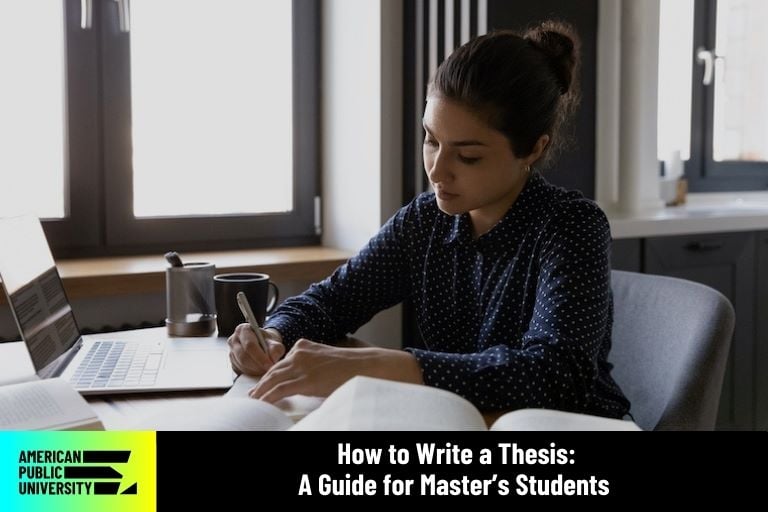By Dr. David James Kritz | 09/29/2023

Let’s face it. Researching and writing a quality thesis can be daunting for many reasons, including:
- A lack of knowledge on where to begin the assignment process
- What key arguments and questions to ask in relation to the thesis statement
- How to get to the data and subject matter
- How to cope with writer's block, a professor's expectations, and time constraints
According to Dictionary.com, a thesis is “a proposition stated or put forward for consideration, especially one to be discussed and proved or to be maintained against objections.”
Therefore, avoiding a weak thesis statement is vital when writing an applicable paper. Thesis statement examples are pivotal in understanding this position.
Currently, master’s students who select the thesis capstone within American Public University's School of Security and Global Studies intelligence master's degree program must choose a relevant subject.
Typically, these students must write a thesis statement that consists of at least one compelling sentence and at least 50 pages of content, then turn it in within 16 weeks.
I have taught graduate students, primarily from the U.S. Intelligence Community, how to conduct research for over eight years.
Based on my experience as an educator, I have 10 tips for creating good thesis statements. These tips, combined with some apt thesis statement examples, can elucidate the process.
Tip #1 for Effective Thesis Statements: Select an Appropriate Topic and Research Question
First, it is necessary to use a lengthy thinking process before developing a good thesis statement, whether it’s an expository thesis statement or an argumentative one. This process begins with many questions related to how to write a thesis statement, such as:
- What would be an interesting topic?
- What would be an original and interesting research question?
- What will be the main claim, key arguments, and central idea of the thesis statement?
- What is an appropriate research design?
- How will I get to the data to address my central research question?
Regardless of the thesis statement or topic, all research begins with a research question.
Without the right question, the analysis, literature review, and implications might miss their mark. This question should be unique, intriguing, and beyond a mere “yes” or “no” answer.
For instance, rather than asking, “Will Country X pursue nuclear proliferation?”, it's better to pose open-ended questions like, “How does…?” or “To what extent…?” Such an approach ensures nuanced and substantive answers.
Additionally, supplementary key questions should support the main research question's depth and intent.
Tip #2: Begin Work on the Thesis Statement and Break Up the Thesis into Manageable Sections
After selecting an appropriate topic and developing a central research question for the thesis statement, it is then necessary to apply the research and writing skills you have learned throughout your degree program.
It might be necessary to refine the thesis statement after some preliminary research; after all, you want a strong thesis statement rather than a weak thesis statement.
It is also essential to break up the thesis paper into manageable sections during the writing process. This strategy will help you to overcome the most common types of mental hurdle of creating a thesis paper that can be 50 or more pages in length.
For writing a thesis statement, this way of thinking is helpful before you begin writing. Instead of attempting to write every single sentence of a thesis statement in one long stretch, you can work on one section at a time, turn it in for review and work on the next section of the thesis statement while awaiting feedback.
Tip #3: Pay Attention to Your Professor's Feedback about Your Assignment
When I give my essay assignment to my students with advice on how to write a thesis, I also explain the importance of a strong thesis statement.
I advise them to avoid becoming emotionally attached to the thesis. That emotional attachment can lead to a battle of wills and wits with the capstone course's professor over the thesis statement examples they present.
When it comes to implementing feedback, revisions to the thesis paper often need to occur. Faculty members are there to help guide you and assist you in the production of a good-quality, argumentative thesis statement that will provide new insights for the reader.
Just go with the feedback you receive from your instructor as you write a sentence, or more, and move on to complete your thesis paper more efficiently.
Tip #4: Complete an Abstract
The abstract of a thesis is vital, so it must be carefully crafted. The abstract may be the only section of a published, scholarly paper or article that someone may take the time to read, based on their time constraints and interest.
Ideally, the abstract should be 250 words or less and must contain the main point of the paper. I advise students drafting an abstract for scholarly journal editors to ensure that the abstract has these elements:
An introductory sentence
A “hook” (why the reader should care about the thesis statement or its topic and to motivate the reader to look at your paper)
The central research question to show the main point of your paper
The research design – how you collected evidence to support your arguments
The results and implications, such as the negative and positive aspects of your main topic and the broader context of your research
Tip #5: Write the Literature Review
When crafting a literature review, incorporate multiple peer-reviewed articles from academic sources like ProQuest and EBSCOHost. Opt for articles frequently cited in other works to enhance your paper's credibility.
The review examines arguments in thesis statements and their counterarguments from scholarly works. For clear discussions, organize your review thematically, showing topic synthesis and your position. This reduces confusion.
For example, if 40 articles discuss open-source intelligence and seven focus on social media, that could be a central theme.
Rather than just listing articles, create broader themes and keep synthesizing. When crafting the thesis, evaluate each paragraph's relevance to the main research question. I advise students to assess the “So what?” factor. If a paragraph isn't pertinent, it might be best to remove it.
Tip #6: Develop a Theoretical Framework within Your Thesis Statement
Theories in theses are often mishandled, reflecting a student’s unclear grasp. Academic theory goes beyond mere "I have a theory" statements and leans on robust, time-tested frameworks.
For instance, a strategic intelligence studies thesis statement might employ national security theory or national defense theory. This theory should align with the thesis's central question.
For example, if probing how Country X uses social media for misinformation, a student might be directed to the communication theory, which aligns well with the study's main topic and question.
Tip #7: Select a Research Design
Before conducting research, students must devise a strategy to address their central question. The research design is their roadmap for data collection. This encompasses methodology, methods, and data gathering instruments like surveys or interviews. Research on humans requires IRB approval, which I advise against due to time constraints in a 16-week paper cycle. Additionally, it's vital to distinguish between “methodology” and “methods,” terms often mistakenly used interchangeably.
Methodology involves the justification of the how and why a research method was selected to address the central research question, according to Indeed. The three primary methodologies include:
- Qualitative methodology
- Quantitative methodology
- Mixed methods
“Mixed methods” involves a researcher’s use of at least one research method from a qualitative methodology and another research method from a quantitative methodology, then explaining how those methods will be integrated into a study.
But if two methods from the same methodology are used in a study, that is referred to as a multi-method approach. An example of a multi-method approach would be using a comparative case study as the first qualitative research method and process tracing as the second research method.
Research methods are linked to either qualitative or quantitative methodologies. They focus on “what” a researcher selected to interpret data.
Research method types include:
- Archival records
- Alternative futures
- Case studies
- Comparative case studies
- Content analysis
- Correlational research
- Descriptive research
- Ethnography
- Experimental research
- Phenomenology
- Process tracing
Tip #8: Write about Research Findings and Data
After gathering data for a thesis, analyzing its significance is crucial, with methods including coding. While qualitative methodology doesn't aim to prove anything, unlike the quantitative approach which tests hypotheses, it can discuss correlations, causation, and delve into theoretical implications in data.
Some may view qualitative research as subjective, but selecting variables in quantitative research has its subjectivity too. Ultimately, it's essential to adhere closely to the scientific method, rather than relying on opinions or claims without concrete evidence.
Tip #9: Consider How Bias Will Affect Your Thesis Statement
When writing thesis statements, it is necessary to consider how bias will affect your writing and your reader. Being 100% objective is an admirable goal, but it is impossible to avoid biases as we are human beings.
All of us have biases, including latent ones. At best, we can mitigate biases, such as using coding software, but never holistically remove bias. As researchers, we just need to be aware of biases and develop strategies to mitigate them.
Tip #10: Be Aware of the Limitations of a Study
The study's limitations section is a pivotal part of a thesis. It highlights the research's shortcomings and indicates what might be done differently.
For instance, a student may mention a 16-week time constraint or contemplate a different research design or question.
This section not only helps students recognize how to enhance their research but also guides future scholars. They can learn from prior omissions or envision alternative research avenues.

